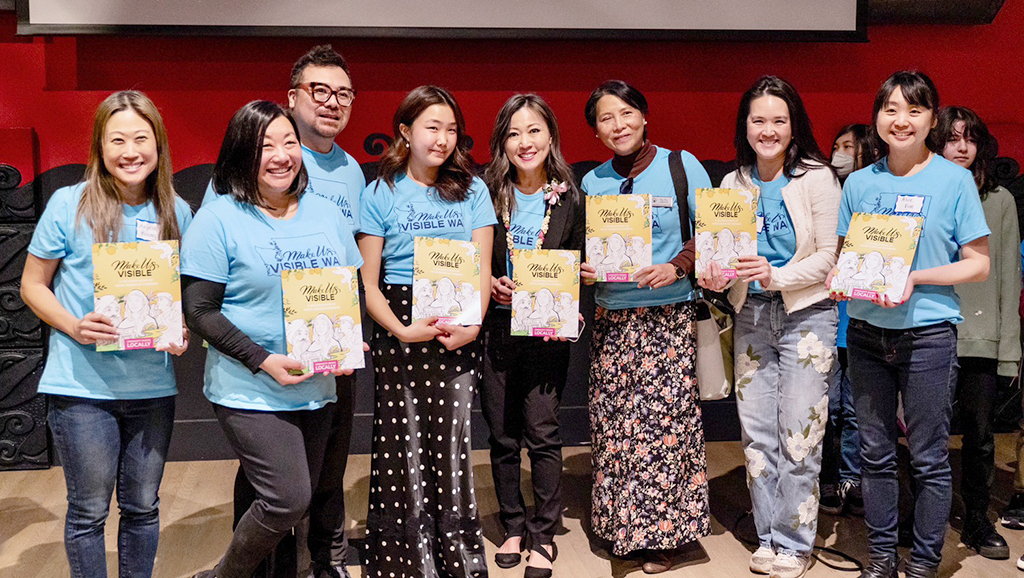By Samantha Pak
NORTHWEST ASIAN WEEKLY
The moment Brett Han discovered Susan Ahn Cuddy—the first female Asian American naval officer—was surreal.
She had known members of the Chinese, Japanese, and Filipino communities who had been in the United States for a long time. However, as a Korean American growing up around first-generation immigrant elders who spoke accented English, Han hadn’t known about her own community’s long history in the country. Learning that Cuddy, a fellow Korean American, had been a U.S. Navy lieutenant during World War II, broke down the “fourth wall” in American history as Han realized she has roots in this country.
“I’m American, too,” she said.
Although most learning tends to happen in the classroom, Han was actually introduced to Cuddy through the five-hour-long PBS documentary series “Asian Americans” (2020), which she binged in one day during her freshman year.
The 17-year-old Seattle Academy senior wants other young people to experience that same kind of empowerment, which is why she joined the steering committee for Make Us Visible Washington (MUV WA)—an organization advocating to make Asian American, Native Hawaiian, and Pacific Islander (AANHPI) history required curriculum in Washington public schools.
The group officially launched in early March, with a kickoff event at the Wing Luke Museum, which was recorded and can be viewed online.
“It’s been in the works,” MUV WA director Angelie Chong said, adding that they had been planning for about a year prior to the launch.
‘This is happening again’
MUV WA is part of the national Make Us Visible (MUV) coalition. According to its website, the organization was formed by two parents and a teacher, who “came together in search of long-term solutions to anti-Asian American violence.”
The idea is that if people learn about Asian Americans and their long history in the country, it humanizes them, and others are more likely to empathize with them and less likely to view Asian Americans as foreigners—which could lead to prejudice, racism, and violence against community members.
“If we can, in the formative years—which is K-12—if we can expose students to the history of our communities, it normalizes it,” Chong said.
In addition, as a parent in the Bellevue School District (which is about 44% AAPI), she wants her kids to know they belong and that this country is their home.
“I would like them to see themselves in history,” Chong said, adding that one of the reasons she became involved with MUV WA was because of the racism her kids had been experiencing. This included a woman driving by them and pulling at the corners at her eyes, as well as being “ching-chonged” because of their last name. The latter led Chong’s son to come home one day and say he wanted to change his last name.
Vivian Song Maritz also saw how the pandemic impacted students of Asian descent—many didn’t want to return to in-person learning once schools opened up, for fear of bullying, or worse. As someone who grew up in the 1980s in the Midwest and saw firsthand how the rise of the Japanese auto industry led to racism against the Asian American community as a whole, she understood that.
“It felt so, ‘This is happening again,’” she said.
Song Maritz didn’t want young people to go through what she did, which is why she ran (and won) to be on the board for Seattle Public Schools, and later joined the MUV WA steering committee.
Like Chong, Song Maritz believes the solution to reducing racism against the community lies in more education, pointing out that “it’s not Asian American history, it’s just American history.” She said we can’t have a complete understanding of American history if we don’t understand the contributions of all groups.
Just getting started
The MUV movement began in January 2021 in Connecticut and has expanded to 13 active state chapters (including Washington)—which are made up of educators, parents, students, and other community members—with three more incoming chapters. Since MUV’s inception, three states (Connecticut, New Jersey, and Rhode Island) have passed legislation to require Asian American and Pacific Islander history in K-12 schools.
Chong said while they all share the same overall goal, each chapter’s efforts look different as they also focus on local history, in addition to national history. This is why here in Washington, they’re also including Native Hawaiian and Pacific Islander history.
MUV WA plans to put together a focus group of teachers to see how they can make teaching AANHPI history feasible. They’re also planning on hosting professional development workshops for teachers who want to include more AANHPI curriculum in their lessons—which will include resources such as The Asian American Education Project, where they can find lesson plans on Asian American history for all grade levels.
“We don’t need to wait for a bill to start teaching this curriculum,” Chong said.
But a bill and eventual law is the goal for MUV WA. Chong said they’re working with state lawmakers to strategize so that when a bill is introduced, they have something that is feasible and not too difficult or complicated for school districts to comply—and as a result, more likely to pass.

Judy Kusakabe is a presenter on stories of Japanese American incarceration during WWII. (Photo by Studio5K)
Although the focus group and teacher workshops are still in the works, MUV WA has already held two narrative workshops on March 21 and 25. These were focused on teaching people how to share their personal stories as a way to advocate for the cause. This is a strategy they used during the MUV WA launch event as speakers (educators, students, and more) from around the state—including Han—shared their personal stories and what it means to them to have the community included in history lessons.
“We’re only getting started,” Han said. “We have a long way to go.”





